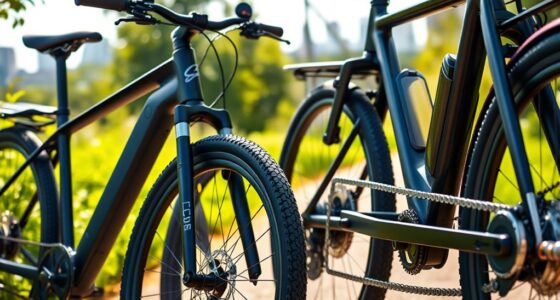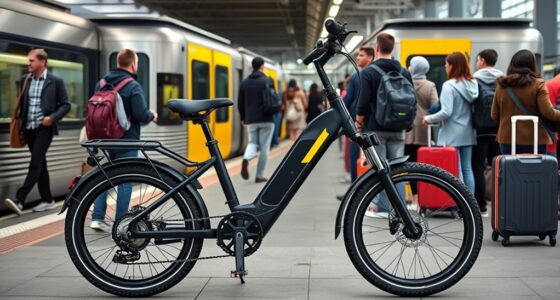Fat-tire e-bikes are rugged bikes with oversized tires designed for rough terrains like sand, snow, and rocky trails. They offer enhanced stability, traction, and comfort, making them ideal for outdoor adventures, urban commuting in challenging conditions, or long rides. If you need extra grip and confidence on difficult surfaces, these bikes could be a great fit. Exploring further reveals more about their features, benefits, and who can get the most from them.
Key Takeaways
- Fat-tire e-bikes feature oversized tires (3.8 inches or wider) for enhanced stability and traction on rough terrains.
- They are ideal for riding on snow, sand, mud, rocky trails, and urban environments with challenging surfaces.
- These e-bikes provide increased comfort, better shock absorption, and longer battery range for extended rides.
- Suitable for outdoor enthusiasts, urban commuters, and recreational riders seeking versatility and easier handling on difficult terrains.
- They help riders with less physical effort, making challenging terrains more accessible and enjoyable.
Defining Fat-Tire E-Bikes
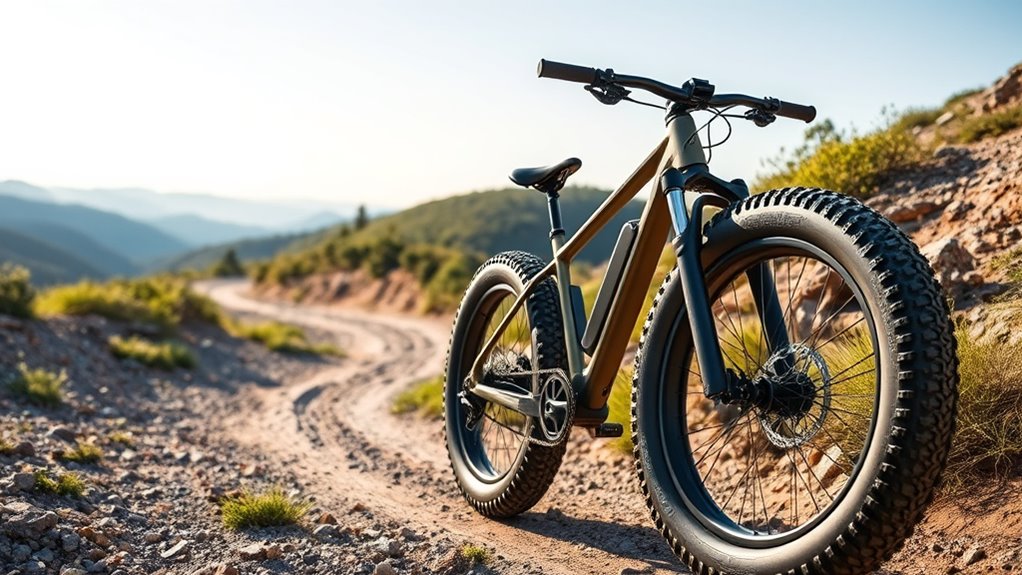
Fat-tire e-bikes are electric bicycles equipped with oversized tires that typically measure 3.8 inches or wider. These bikes are versatile, designed to handle rough terrains and provide stability. If you enjoy mountain biking, you’ll appreciate their ability to absorb shocks and navigate uneven trails with ease. For urban commuters, fat-tire e-bikes offer a smooth ride over potholes, sand, or snow, making city travel more comfortable and efficient. Their wide tires provide excellent traction and balance, enhancing safety in diverse conditions. Whether you’re tackling challenging off-road adventures or cruising through city streets, fat-tire e-bikes deliver durability, comfort, and versatility, making them suitable for a range of riding styles and environments.
Key Features and Specifications
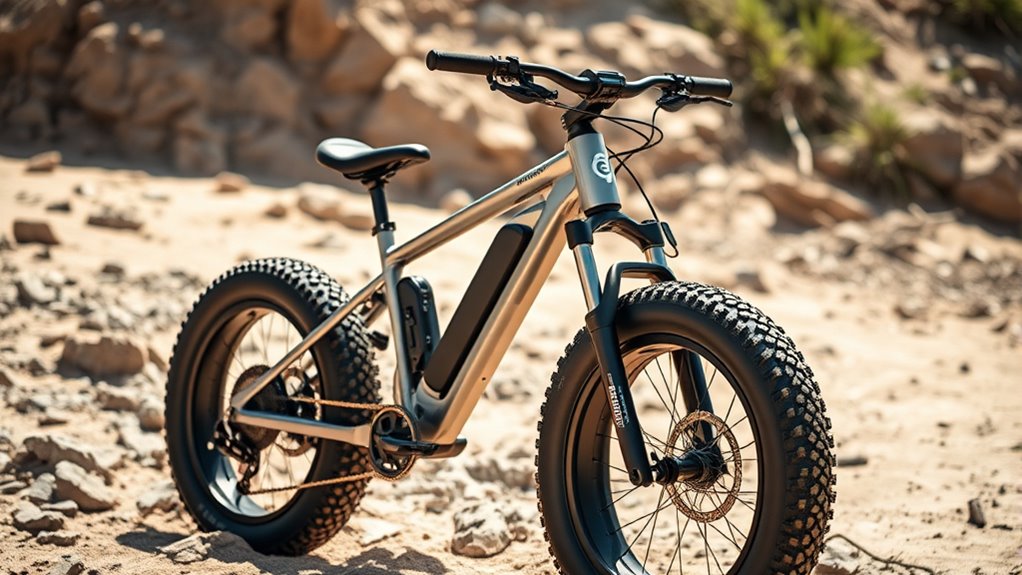
Fat-tire e-bikes excel in providing enhanced traction, making them perfect for tough terrains and loose surfaces. Their robust tire specifications guarantee durability and stability, even in challenging conditions. Understanding these key features helps you choose a bike that offers reliable performance wherever you ride. Additionally, the navigation technology in some models ensures precise control and safety on unpredictable paths.
Enhanced Traction Capabilities
Thanks to their wider contact patches and specialized tread patterns, fat-tire e-bikes deliver exceptional traction across challenging terrains. You’ll notice improved grip on snow, sand, mud, and rocky trails, giving you confidence with every pedal stroke. To optimize traction, adjusting tire pressure is essential—lower pressures increase surface contact, enhancing grip without risking pinch flats. Modern suspension systems also play a critical role, absorbing shocks and maintaining tire contact on uneven surfaces. Additional features include:
- Wide tires for increased surface area
- Tread designs tailored for specific terrains
- Adjustable tire pressure for different conditions
- Front and rear suspension for stability
- Reinforced sidewalls for durability
These elements work together to guarantee your fat-tire e-bike maintains superior traction, even in the most demanding environments. Proper tire maintenance is also crucial, ensuring your tires stay in optimal condition for maximum grip.
Robust Tire Specifications
Robust tire specifications are the backbone of reliable fat-tire e-bikes, guaranteeing durability and performance across rough terrains. The tire width plays a vital role, providing the stability and grip needed for challenging conditions. Wide tires distribute weight more evenly, reducing the risk of punctures and wear. Additionally, effective pressure regulation is essential for peak performance; maintaining the correct tire pressure improves traction, cushioning, and efficiency. Fat-tire e-bikes often feature tires that can handle a wide pressure range, allowing you to adapt to different surfaces like snow, sand, or rocky trails. When choosing a fat-tire e-bike, pay close attention to tire specifications, including width and recommended pressure settings, to guarantee your ride remains smooth, safe, and capable in any environment. Understanding tire pressure management is essential for optimizing ride quality and longevity of your tires.
Ideal Terrain and Riding Conditions
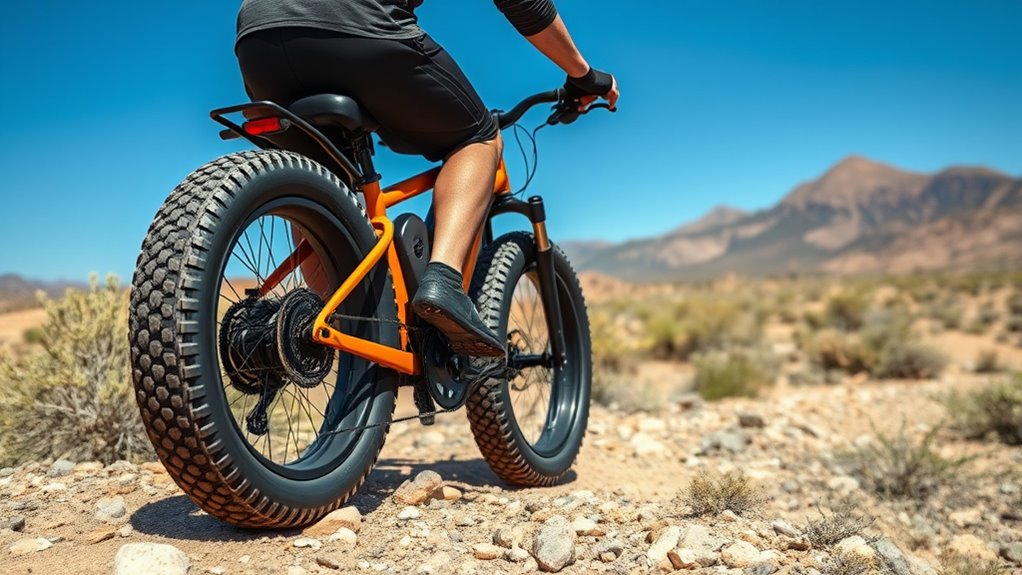
Fat-tire e-bikes excel on rough terrains like mud, gravel, and rocky trails, thanks to their off-road durability. They handle snow and sand with ease, making winter rides or beach trips more enjoyable. Whether you’re tackling rugged trails or soft surfaces, these bikes are built for versatile riding conditions.
Off-Road Durability
Fat-tire e-bikes excel off-road when you ride on terrain with loose soil, snow, or sand, thanks to their wide tires and low-pressure design. They’re built to handle rough conditions while maintaining durability and stability. On challenging trails, your bike’s reinforced frame and robust tires resist punctures and abrasions, ensuring longevity. While great for off-road adventures, they also excel in urban commuting and can handle mixed terrains that include uneven pavement. For road cycling, their weight and rolling resistance may be less ideal, but durability remains impressive. Keep in mind these factors for off-road durability:
- Reinforced frames resist impacts and abrasions
- Wide tires distribute weight evenly
- Low-pressure design absorbs shocks
- Strong rims withstand rough terrain
- Quality suspension options improve control
- Enhanced traction is achieved through the combination of wide tires and low-pressure design, making them especially effective on loose or uneven surfaces.
Snow and Sand Performance
When riding on snow or sand, your bike’s wide, low-pressure tires shine by providing exceptional traction and stability. This makes them ideal for tackling challenging terrains where narrow tires would slip and lose control. Fat-tire e-bikes excel in urban commuting scenarios as well, offering a smooth, confident ride across snowy sidewalks or sandy paths. Their aesthetic design often complements their rugged performance, blending style with functionality. Whether you’re steering through winter city streets or exploring beachside trails, these bikes deliver reliable grip and comfort. The broad tires distribute weight evenly, reducing sinking and enhancing control. Kia Tuning techniques, such as suspension upgrades, can further improve ride quality on rough terrains. So, if you need a versatile bike that performs well on snow and sand, fat-tire e-bikes are a smart choice for both practical and aesthetic reasons.
Rugged Trail Compatibility
Rugged trail riding demands a bike that can handle uneven surfaces, loose gravel, rocks, and roots with confidence. Fat‑tire e‑bikes excel here, offering stability and traction on challenging terrain. Their wide tires absorb shocks and grip loose surfaces, making them ideal for off-road adventures. While they’re perfect for rugged trails, they also shine in urban commuting, where rough roads and potholes are common. Plus, their versatility extends to indoor cycling, providing a dynamic workout on stationary setups. Consider these features for rugged trail compatibility:
- Wide tires for traction on uneven terrain
- Strong frame for rough handling
- Powerful motor for steep inclines
- Durable components for longevity
- Versatility for urban and indoor use
This makes fat‑tire e‑bikes a flexible choice for diverse riding conditions. Rugged terrain capabilities are a key advantage, ensuring riders can confidently navigate a variety of challenging surfaces.
Who Can Benefit From Fat-Tire E-Bikes
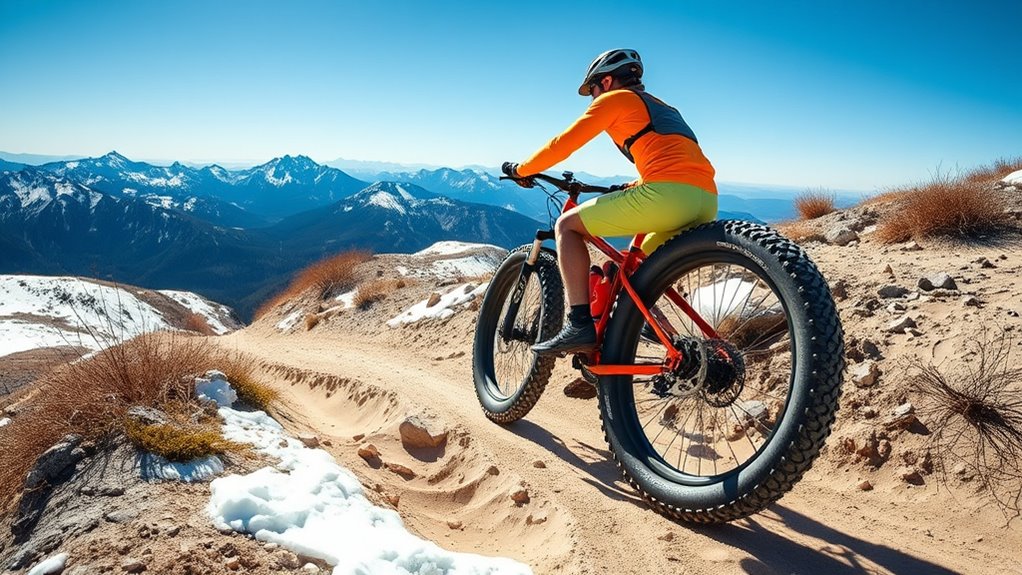
Wondering if a fat-tire e-bike is right for you? If you’re an urban commuter, it could be a game-changer, helping you navigate rough roads, snow, or sand with ease. The extra traction and stability make your daily ride smoother and safer, even on challenging surfaces. Recreational cyclists also benefit, especially if you enjoy exploring varied terrains or tackling long, demanding rides. Fat-tire e-bikes make outdoor adventures more accessible and enjoyable by reducing fatigue and providing extra power when needed. Whether you’re commuting through city streets or heading out on weekend excursions, these bikes adapt to different conditions and riding styles. If versatility and comfort matter to you, a fat-tire e-bike might be exactly what you need. Incorporating natural materials can enhance the rustic charm and authenticity of your cycling experience.
Advantages Over Traditional Bicycles
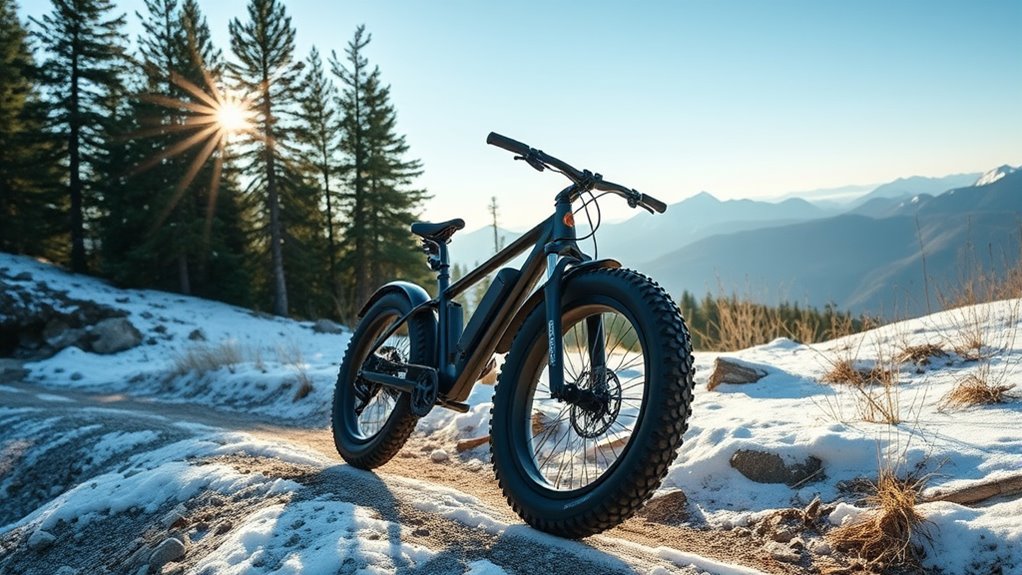
Fat-tire e-bikes offer several advantages over traditional bicycles, primarily thanks to their enhanced design and power features. You’ll benefit from increased battery range, allowing longer rides without frequent recharges. The powerful motors provide extra assistance, making climbs and rough terrains easier to conquer. Their wider tires improve stability and traction, especially on loose or uneven surfaces. Additionally, fat-tire e-bikes require less physical effort, making cycling accessible for more people. They also excel in versatility, suitable for snow, sand, and mountain trails. These benefits combine to create a more comfortable, capable riding experience. The wide tires also contribute to better shock absorption, enhancing ride comfort on rough terrains.
Considerations Before Making a Purchase
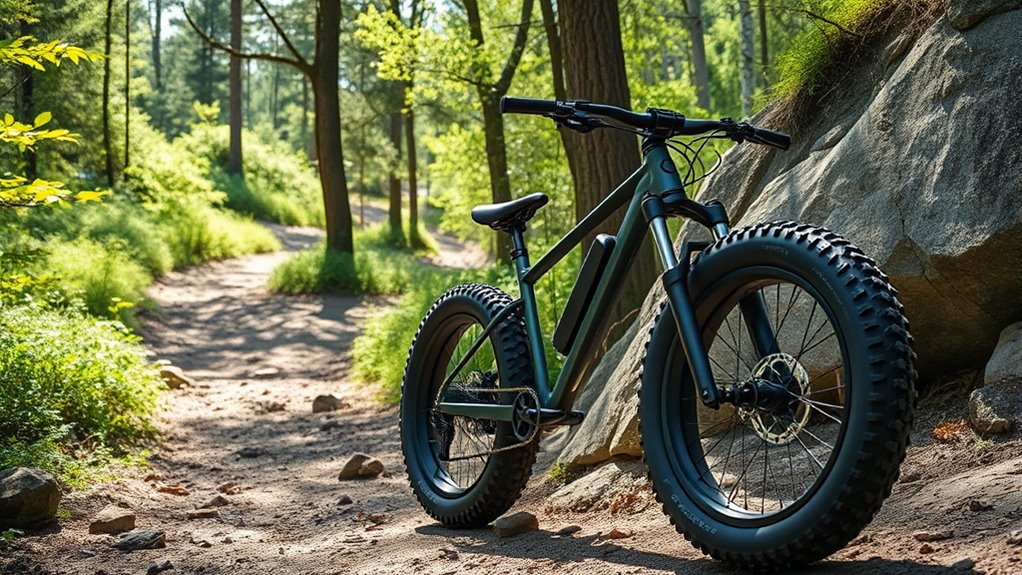
Before purchasing a fat-tire e-bike, it’s important to contemplate your specific riding needs and the terrain you’ll encounter most often. Consider how far you typically ride; battery range varies widely, so choose a model with enough capacity to meet your distance requirements without frequent recharging. Think about terrain—if you ride on snow, sand, or rough trails, a fat-tire e-bike offers better stability and traction. Price considerations are also essential; these bikes can be an investment, so set a budget that aligns with your usage frequency and features you need. Higher-end models often have longer battery life and advanced features, but there are also more affordable options that still deliver good performance. Carefully weigh these factors to make an informed choice. Additionally, understanding the role of tire size and technology can help you select the most suitable model for your needs.
Frequently Asked Questions
How Long Do Fat-Tire E-Bike Batteries Typically Last per Charge?
You’ll find that fat-tire e-bike batteries typically last between 20 to 50 miles per charge, depending on factors like terrain and rider weight. Their battery lifespan usually spans 500 to 1,000 charge cycles, meaning you can expect several years of reliable use before performance declines. Proper maintenance, such as avoiding extreme temperatures and not fully discharging the battery, helps prolong its life and guarantees maximum performance over time.
Are Fat-Tire E-Bikes Suitable for Urban Commuting?
You’ll find fat-tire e-bikes great for urban commuting, especially if you prioritize urban safety. Their wide tires provide better stability and grip on uneven city surfaces, and you can adjust tire pressure for different conditions. Plus, their powerful motors help you navigate traffic smoothly. Just make certain you maintain proper tire pressure to maximize safety and efficiency, making your daily ride comfortable and secure in city environments.
What Is the Average Cost Range for Different Fat-Tire E-Bike Models?
You might worry about high prices, but fat-tire e-bike costs vary widely. Price variations depend on features, battery life, and brand options. Entry-level models start around $1,500, while premium bikes can reach $4,000 or more. Consider your needs and budget, as there are quality choices across different price ranges. This way, you can find a fat-tire e-bike that balances performance and affordability for your adventures.
How Much Maintenance Do Fat-Tire E-Bikes Require?
Fat-tire e-bikes need regular maintenance to keep them running smoothly. You should check tire wear frequently and replace tires when they’re worn out to prevent flats. Brake adjustments are also essential to guarantee safe stopping power. Additionally, keep the chain lubricated and inspect the battery and motor regularly. With proper upkeep, your fat-tire e-bike will perform well on tough terrains and last longer.
Can Fat-Tire E-Bikes Be Used for Mountain Biking?
Think of fat-tire e-bikes as the tanks of the trail. Yes, you can use them for mountain biking, but you’ll want to adjust tire pressure for rough terrain and guarantee your suspension system is tuned for shock absorption. Their wide tires provide stability, and the electric assist helps you conquer steep climbs. Just remember, they excel on soft, uneven surfaces, making them a versatile choice for adventurous mountain bikers.
Conclusion
If you’re seeking a versatile ride that conquers any terrain like a trusty steed, fat-tire e-bikes are your answer. They open up worlds of adventure, whether you’re tackling snow, sand, or rugged trails. Think of them as your all-access pass to explore new horizons with ease and confidence. So, if you’re ready to turn every path into your personal playground, investing in a fat-tire e-bike could be your game-changer—your ticket to riding beyond limits.



